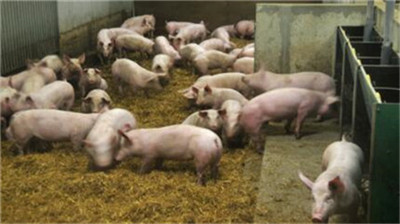The cause of sow second birth syndrome affects the economic benefits of this pig farm!
There are many causes of second birth syndrome in sows, including nutrition, management, epidemic disease and so on, which are mainly related to the feeding and management of reserve sows.
1. Insufficient supply of reproductive nutrition.
During the breeding period, reserve sows do not use special reserve pig feed, and some even use fat pig feed, resulting in a lack of reproductive nutrition to maintain the reproductive performance of sows.
2. The first mating age is too early, and the sows are underdeveloped.
The reserve sows are eager to breed after estrus, ignoring the first mating age, body weight and fatness of the sows, and the mating age is too early. Although the reserve sows are sexually mature when they are in estrus, they have not yet reached the standard of physical maturity, and the reproductive system is not fully mature, which easily leads to dystocia.
3. Mycotoxin accumulation poisoning
The quality of feed raw materials is poor, and sows eat feed with excessive mycotoxin for a long time, which leads to mycotoxin accumulation poisoning and damages the reproductive system and immune system.
4. Insufficient nutrition supply during pregnancy
After mating, the self-development of reserve sows is far from reaching the state of body maturity, so they must obtain sufficient nutrients to meet the needs of fetal development on the one hand and their own sustainable development on the other hand, while the feeding and management plan during pregnancy is improper. the balance between the development of the reserve sow itself and the growth and development of the fetus is not grasped, which leads to the second birth of the sow.

5. Excessive weightlessness during lactation
The feed intake of newborn sows is low during lactation, the milk absorption capacity of piglets is strong, and there is a "scissors gap" between supply and demand. The fat loss of sows is more serious than that of sows. On the other hand, the nutrition supply plan of sows during lactation was wrong, which led to excessive weight loss, low body fat and thin backfat, so that sows could not be in estrus in time after weaning.
6. improper perinatal health care, acute and recessive endometritis in sows.
One week before and after delivery of sows is the most intense stress stage of sows, the resistance decreases, the reproductive system is very easy to be infected with pathogenic microorganisms, and sows develop endometritis, which makes sows lose their reproductive ability temporarily or for life.
7. Infection with reproductive disorders
Sows are infected with blue ear disease, pseudorabies, classical swine fever, eperythrozoon, chlamydia and other reproductive disorders.
Solution:
1. Strengthen the feeding and management of reserve sows and select suitable reserve sows for breeding.
two。 It is necessary to select good feed materials and feed, and do not use moldy and deteriorated feed to feed sows, and in view of the actual situation of raw feed grains in China being contaminated by mycotoxins, anti-mildew, detoxification or drugs should be added to the feed.
3. A reasonable nutrition scheme should be used to raise reserve sows. When using 50-75kg pig feed, 75kg to breeding using special backup pig feed, or using lactating sow feed, you must not use fat pig feed to raise reserve sows.
4. Starting from the reserve sow weight of 50 kg, increase the supply of reproductive nutrition.
5. In the backup stage, the sows were vaccinated strictly according to the set immune procedure, such as classical swine fever, pseudorabies, fine, Japanese encephalitis and so on.
6. Determine the appropriate age and weight for the first match
The first mating age of binary hybrid sows should be about 8 months old and the body weight is 130-140 kg, and the age of purebred sows can be postponed appropriately.
7. Minimize weightlessness during lactation
One is to carry out full feeding during the lactation period, increase the feeding times, increase the nutrient concentration, and add 5% oil or 10% expanded soybeans to the feed to prevent insufficient nutrition intake or excessive consumption.
8. To control the number of sows, generally do not exceed 13-14, weaning time is about 23-25 days, lactation time can not be too long, otherwise the phenomenon of weightlessness is more serious.
9. Do a good job of postpartum health care
Sow 3 days postpartum due to pay attention to sow inflammation or other diseases, due to timely treatment.
- Prev

Boar semen 30 questions (very authoritative), remember to collect after reading!
Boar semen 30 questions (very authoritative), remember to collect after reading!
- Next

Piglets don't eat ingredients? What should be paid attention to in the early feeding and food inducement?
Piglets don't eat ingredients? What should be paid attention to in the early feeding and food inducement?
Related
- On the eggshell is a badge full of pride. British Poultry Egg Market and Consumer observation
- British study: 72% of Britons are willing to buy native eggs raised by insects
- Guidelines for friendly egg production revised the increase of space in chicken sheds can not be forced to change feathers and lay eggs.
- Risk of delay in customs clearance Australia suspends lobster exports to China
- Pig semen-the Vector of virus Transmission (4)
- Pig semen-the Vector of virus Transmission (3)
- Five common causes of difficult control of classical swine fever in clinic and their countermeasures
- Foot-and-mouth disease is the most effective way to prevent it!
- PED is the number one killer of piglets and has to be guarded against in autumn and winter.
- What is "yellow fat pig"? Have you ever heard the pig collector talk about "yellow fat pig"?

